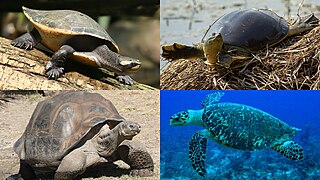
Turtles are reptiles of the order Testudines, characterized by a special shell developed mainly from their ribs. Modern turtles are divided into two major groups, the Pleurodira and Cryptodira, which differ in the way the head retracts. There are 360 living and recently extinct species of turtles, including land-dwelling tortoises and freshwater terrapins. They are found on most continents, some islands and, in the case of sea turtles, much of the ocean. Like other amniotes they breathe air and do not lay eggs underwater, although many species live in or around water.

A cephalopod is any member of the molluscan class Cephalopoda such as a squid, octopus, cuttlefish, or nautilus. These exclusively marine animals are characterized by bilateral body symmetry, a prominent head, and a set of arms or tentacles modified from the primitive molluscan foot. Fishers sometimes call cephalopods "inkfish", referring to their common ability to squirt ink. The study of cephalopods is a branch of malacology known as teuthology.

Gastropods, commonly known as slugs and snails, belong to a large taxonomic class of invertebrates within the phylum Mollusca called Gastropoda.

Hermit crabs are anomuran decapod crustaceans of the superfamily Paguroidea that have adapted to occupy empty scavenged mollusc shells to protect their fragile exoskeletons. There are over 800 species of hermit crab, most of which possess an asymmetric abdomen concealed by a snug-fitting shell. Hermit crabs' soft (non-calcified) abdominal exoskeleton means they must occupy shelter produced by other organisms or risk being defenseless.

Scallop is a common name that encompasses various species of marine bivalve mollusks in the taxonomic family Pectinidae, the scallops. However, the common name "scallop" is also sometimes applied to species in other closely related families within the superfamily Pectinoidea, which also includes the thorny oysters.
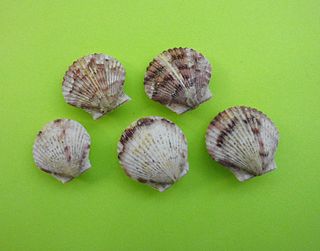
Argopecten gibbus, the Atlantic calico scallop, is a species of medium-sized edible marine bivalve mollusk in the family Pectinidae, the scallops.
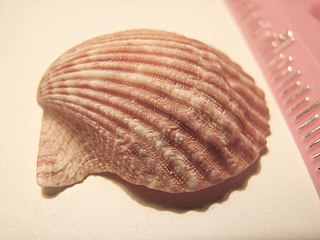
The rough scallop, Aequipecten muscosus, grows up to 1.75 in (4.4 cm). It has a small, scallop-shaped shell with about 20 strong ribs which have many erect scales or small spines near the margin. The hinge line has ears.

Crepidula fornicata is a species of medium-sized sea snail, a marine gastropod mollusc in the family Calyptraeidae, the slipper snails and cup and saucer snails. It has many common names, including common slipper shell, common Atlantic slippersnail, boat shell, quarterdeck shell, fornicating slipper snail, Atlantic slipper limpet and it is in Britain as the "common slipper limpet".

The gastropod shell is part of the body of a gastropod or snail, a kind of mollusc. The shell is an exoskeleton, which protects from predators, mechanical damage, and dehydration, but also serves for muscle attachment and calcium storage. Some gastropods appear shell-less (slugs) but may have a remnant within the mantle, or in some cases the shell is reduced such that the body cannot be retracted within it (semi-slug). Some snails also possess an operculum that seals the opening of the shell, known as the aperture, which provides further protection. The study of mollusc shells is known as conchology. The biological study of gastropods, and other molluscs in general, is malacology. Shell morphology terms vary by species group.

The queen scallop is a medium-sized species of scallop, an edible marine bivalve mollusk in the family Pectinidae, the scallops. It is found in the northeast Atlantic and is important in fisheries.

Aequipecten is a genus of scallops, marine bivalve mollusks in the family Pectinidae.
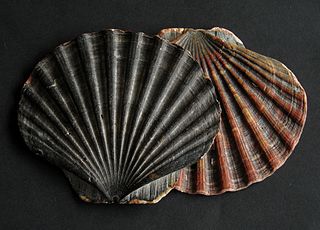
Pecten maximus, common names the great scallop, king scallop, St James shell or escallop, is a northeast Atlantic species of scallop, an edible saltwater clam, a marine bivalve mollusc in the family Pectinidae. This is the type species of the genus. This species may be conspecific with Pecten jacobaeus, the pilgrim's scallop, which has a much more restricted distribution.

Scallop aquaculture is the commercial activity of cultivating (farming) scallops until they reach a marketable size and can be sold as a consumer product. Wild juvenile scallops, or spat, were collected for growing in Japan as early as 1934. The first attempts to fully cultivate scallops in farm environments were not recorded until the 1950s and 1960s. Traditionally, fishing for wild scallops has been the preferred practice, since farming can be expensive. However worldwide declines in wild scallop populations have resulted in the growth of aquaculture. Globally the scallop aquaculture industry is now well established, with a reported annual production totalling over 1,200,000 metric tonnes from about 12 species. China and Japan account for about 90% of the reported production.
Tumidotheres maculatus is a species of crab that lives commensally or parasitically in the mantle cavity of molluscs. It is found along much of the western Atlantic Ocean and was first described by Thomas Say in 1818.
Aequipecten acanthodes, the thistle scallop, is a species of bivalve mollusc in the family Pectinidae. It can be found in Caribbean waters, ranging from southern Florida to Bermuda.

Serpula vermicularis, known by common names including the calcareous tubeworm, fan worm, plume worm or red tube worm, is a species of segmented marine polychaete worm in the family Serpulidae. It is the type species of the genus Serpula and was first described by Carl Linnaeus in his 1767 12th edition of Systema Naturae. It lives in a tube into which it can retract.
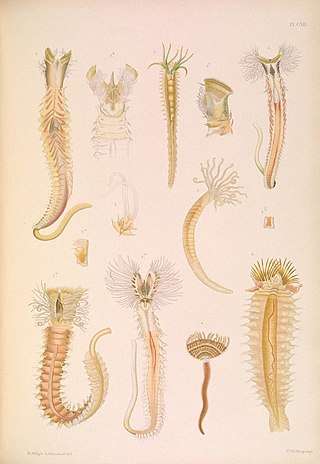
Sabellaria spinulosa is a species of marine polychaete worm in the family Sabellariidae, commonly known as the Ross worm. It lives in a tube built of sand, gravel and pieces of shell.
Aggregata is a genus of parasitic alveolates belonging to the phylum Apicomplexa.

The San Matias Gulf is an inlet of the Atlantic Ocean off the coast of Patagonia, Argentina. It is bordered by the Río Negro Province to the north and west, and the Valdes Peninsula of the Chubut Province to the south. It is "one of the largest gulfs in the Patagonia region". The gulf is surrounded by plateaus and depressions below sea level similar to the gulf itself but that are not flooded by the sea at present.
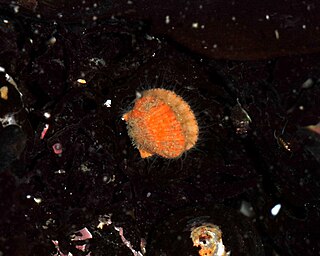
Leptopecten latiauratus, common name the kelp scallop, is a small saltwater clam, a bivalve mollusk in the family Pectinidae, the scallops. It lives in water up to 850 feet deep. Like other scallops it has many small primitive eyes around the rim of its mantle and escapes predators by jet propulsion.

















